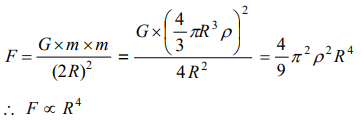1. Earth binds the atmosphere because of
a) Gravity
b) Oxygen between earth and atmosphere
c) Both (a) and (b)
d) None of these
Explanation: Gravity
2. Which of the following statements about the gravitational constant is true
a) It is a force
b) It has no unit
c) It has same value in all systems of units
d) It does not depend on the nature of the medium in which the bodies are kept
Explanation: It does not depend on the nature of the medium in which the bodies are kept
3. Two identical solid copper spheres of radius R placed in contact with each other. The gravitational attracton between them is
proportional to
a) \[R^{2}\]
b) \[R^{-2}\]
c) \[R^{4}\]
d) \[R^{-4}\]
Explanation:

4. Weightlessness experienced while orbiting the earth in space-ship, is the result of
a) Inertia
b) Acceleration
c) Zero gravity
d) Free fall towards
earth
Explanation: Free fall towards earth
5. The time period of a simple pendulum on a freely moving artificial satellite is
a) Zero
b) 2 sec
c) 3 sec
d) Infinite
Explanation:

6. Two planets have the same average density but their radii are \[R_{1}\] and \[R_{2}\] . If acceleration due to
gravity on these planets be \[g_{1}\] and \[g_{2}\] respectively, then
a) \[\frac{g_{1}}{g_{2}}=\frac{R_{1}}{R_{2}}\]
b) \[\frac{g_{1}}{g_{2}}=\frac{R_{2}}{R_{1}}\]
c) \[\frac{g_{1}}{g_{2}}=\frac{R_1^2}{R_2^2}\]
d) \[\frac{g_{1}}{g_{2}}=\frac{R_1^3}{R_2^3}\]
Explanation:

7. An iron ball and a wooden ball of the same radius are released from a height ‘h’ in vacuum. The time taken by both of them to reach the ground is
a) Unequal
b) Exactly equal
c) Roughly equal
d) Zero
Explanation:

8. The correct answer to above question is based on
a) Acceleration due to gravity in vacuum is same irrespective of size and mass of the body
b) Acceleration due to gravity in vacuum depends on the mass of the body
c) There is no acceleration due to gravity in vacuum
d) In vacuum there is resistance offered to the motion of the body and this resistance depends on the mass of the body
Explanation: Acceleration due to gravity in vacuum is same irrespective of size and mass of the body
9. When a body is taken from the equator to the poles, its weight
a) Remains constant
b) Increases
c) Decreases
d) Increases at N-pole and decreases at S-pole
Explanation: Because acceleration due to gravity increases
10. A body of mass m is taken to the bottom of a deep mine. Then
a) Its mass increases
b) Its mass decreases
c) Its weight increases
d) Its weight decreases
Explanation: Because acceleration due to gravity decreases